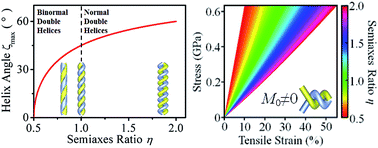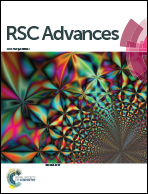Mechanical properties of normal and binormal double nanohelices†
Abstract
Double helix structures, ubiquitous in nature from nano- to macro- scales, have attracted particular interest due to their unique morphology. Compared to the double nanohelices with the commonest circular cross sections, those with asymmetric cross sections have better mechanical properties for applications in micro-/nanoelectromechanical systems (MEMS/NEMS). In this paper, a novel theoretical basis is proposed based on the extensible Cosserat curve for quantitatively exploring statics and dynamics of the double nanohelices with elliptic cross sections. The normal double nanohelices made up of straight wires rather than single helices are quantitatively confirmed to excel the binormal and rope-like double nanohelices in both load capacity and elasticity, and retain the mechanical stability at the same time. We obtain the interlocking helix angle as well as the minimum boundary value of semiaxes ratio to form a tightly packed double helix. A set of expressions are derived that can be used to measure the mechanical properties of the double helix system under uniaxial stretching, such as the interaction between the strands, tensile modulus and torque. The present work provides useful information for future experimental investigation on normal and binormal double nanohelices as well as their applications in micro-/nanoscale devices.


 Please wait while we load your content...
Please wait while we load your content...